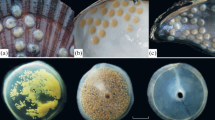Abstract
The effects of temperature and body size on the intermolt periods (molting frequencies) of the North Pacific euphausíid Euphausia pacifica and the Mediterranean forms of Meganyctiphanes norvegica, Euphausia krohnii, Nematoscelis megalops, and Nyctiphanes couchii were studied under controlled conditions in the laboratory. Mean intermolt periods for E. pacifica and M. norvegica were inversely and linearly related to temperature, over temperature ranges which the euphausiids normally encounter in the sea. At higher temperatures there was a tendency for three size groups of M. norvegica to approach a minimum intermolt period independent of temperature. M. norvegica cycled for different time periods between 13° and 18°C molted regularly at mean frequencies which would be expected if the animals had been held constantly at the timeweighted means of the two experimental temperatures. The increase in mean intermolt period per unit weight was faster in small, fast-growing M. norvegica than in large, slow-growing adults. This relationship was corroborated by following the changes in the intermolt period of an actively growing individual N. couchii over an 11 month period. Neither feeding nor the time of year of collection affected the molting frequency as long as temperature and animal weight were held constant. No tendency was found for euphausiids of the same species and/or size, and from the same collection, to molt on the same night. Molting occurred at night 80 to 90% of the time for all species, over the temperature ranges normally experienced by the euphausiids in the sea, and over all animal weights tested. There appeared to be a weakening of the night-time molting rhythm at low temperatures. Although neither temperature nor anímal weight substantially affected the night-time molting rhythm, both affected the mean intermolt period. Therefore, both temperature and body size apparently act together to adjust the length of the intermolt period of each individual in increments of whole days, but they exert little control over time of molting within any 24h period. No information was obtained regarding the factors which specify night-time molting over daytime molting within any 24 h period; however, regulation of certain hormone activities is probably involved.
Similar content being viewed by others
Literature cited
Bückmann, D. and D. Adelung: Der Einfluß der Umweltfaktoren auf das Wachstum und den Häutungsrhythmus der Strandkrabbe Carcinides maenas. Helgoländer wiss. Meeresunters. 10, 91–103 (1964).
Conover, R. J.: Notes on the molting cycle, development of sexual characters and sex ratio in Calanus hyperboreus, Crustaceana 8, 308–320 (1965).
Drach, P.: Etude préliminaire sur le cycle d'intermue et son conditionnement hormonal chez Leander serratus (Pennant). Bull biol. Fr. Belg. 78, 40–62 (1944).
Einarsson, H.: Euphausiacea. 1. North Atlantic species. Dana Rep. 27, 1–185 (1945).
Fisher, L. R., S. K. Kon and S. Y. Thompson: Vitamin A and carotenoids in some Mediterranean Crustacea with a note on the swarming of Meganyctiphanes. Bull. Inst. océanogr. Monaco No. 1021, 1–19 (1953).
Fowler, S. W., L. F. Small and J. M. Dean: Metabolism of zinc-65 in euphausiids. In: Symposium on radioecology, Proceedings of the Second National Symposium. pp 391–411. Ed. by D. J. Nelson and F. C. Evans. USAEC-CONF-670503 1969.
Hela, I., E. Gilat and J. C. Martin: Study of an ecosystem in coastal waters of the Ligurian Sea. I. Hydrographic conditions. Bull. Inst. océanogr. Monaco 63 (1306), 1–20 (1964).
Hess, W. N.: Factors influencing moulting in the crustacean Crangon armillatus. Biol. Bull. mar. biol. Lab., Woods Hole 81, 215–220 (1941).
Jerde, C. W. and R. Lasker: Molting of euphausiid shrimps: shipboard observations. Limnol. Oceanogr. 11, 120–124 (1966).
Kinne, O.: Temperature. Animals: invertebrates. In: Marine ecology, Vol. 1, pp 407–514. Ed. by O. Kinne. London: Wiley-Interscience 1970.
Komaki, Y.: Technical notes on keeping euphausiids live in the laboratory, with a review of experimental studies on euphausiids. Inf. Bull. Planktol. Japan 13, 95–105 (1966).
Lasker, R.: Molting frequency of a deep-sea crustacean, Euphausia pacifica. Nature, Lond. 203, 96 (1964).
— Feeding, growth, respiration and carbon utilization of a euphausiid crustacean. J. Fish. Res. Bd Can. 23, 1291–1317 (1966).
Lewis, J. B.: The occurrence and vertical distribution of the Euphausiacea of the Florida Current. Bull. mar. Sci. Gulf Caribb. 4, 265–301 (1954).
Mackintosh, N. A.: The maintenance of living Euphausia superba and frequency of moults. Norsk Hvalfangsttid. 5, 97–102 (1967).
Mauchline, J.: The biology of the euphausiid crustacean, Meganyctiphanes norvegica (M. Sars). Proc. R. Soc. Edinb. (Sect. B, Biol.) 67, 141–179 (1960).
— and L. R. Fisher: The biology of euphausiids. Adv. mar. Biol. 7, 1–454 (1969).
Meixner, R.: Wachstum, Häutung und Fortpflanzung von Crangon crangon (L.) bei Einzelaufzucht. Ber. dt. wiss. Kommn Meeresforsch. 20 (H. 2), 93–111 (1969).
Needham, A. E.: Ecdysis and growth in Crustacea. Nature, Lond. 158, 667–668 (1946).
Paranjape, M. A.: Molting and respiration of euphausiids. J. Fish. Res. Bd Can. 24, 1229–1240 (1967).
Passano, L. M.: Molting and its control. In: The physiology of Crustacea, Vol. 1, pp 473–536. Ed. by T. H. Waterman. New York: Academic Press 1960.
Pearcy, W. G. and L. F. Small: Effects of pressure on the respiration of vertically migrating crustaceans. J. Fish. Res. Bd Can. 25, 1311–1316 (1968).
Small, L. F. and J. F. Hebard: Respiration of a vertically migrating marine crustacean Euphausia pacifica Hansen. Limnol. Oceanogr. 12, 272–280 (1967).
Teal, J. M. and F. G. Carey: Effects of pressure and temperature on the respiration of euphausiids. Deep Sea Res. 14, 725–733 (1967).
Travis, D. F.: The molting cycle of the spiny lobster, Panuliris argus Latreille. I. Molting and growth in laboratory maintained individuals. Biol. Bull. mar. biol. Lab., Woods Hole 107, 433–450 (1954).
Trégouboff, G.: Prospection biologique sous-marine dans la région de Villefranche-sur-Mer en juillet-août 1960. Bull. Inst. océanogr. Monaco 58 (1220), 1–14 (1961).
Author information
Authors and Affiliations
Additional information
Communicated by J. M. Peres, Marseille
Rights and permissions
About this article
Cite this article
Fowler, S.W., Small, L.F. & Kečkeš, S. Effects of temperature and size on molting of euphausiid crustaceans. Marine Biology 11, 45–51 (1971). https://doi.org/10.1007/BF00348020
Accepted:
Issue Date:
DOI: https://doi.org/10.1007/BF00348020




